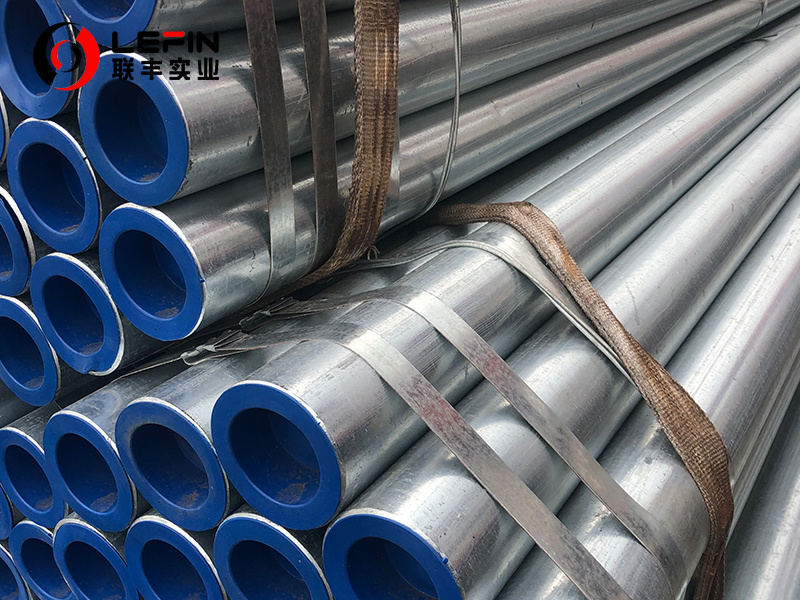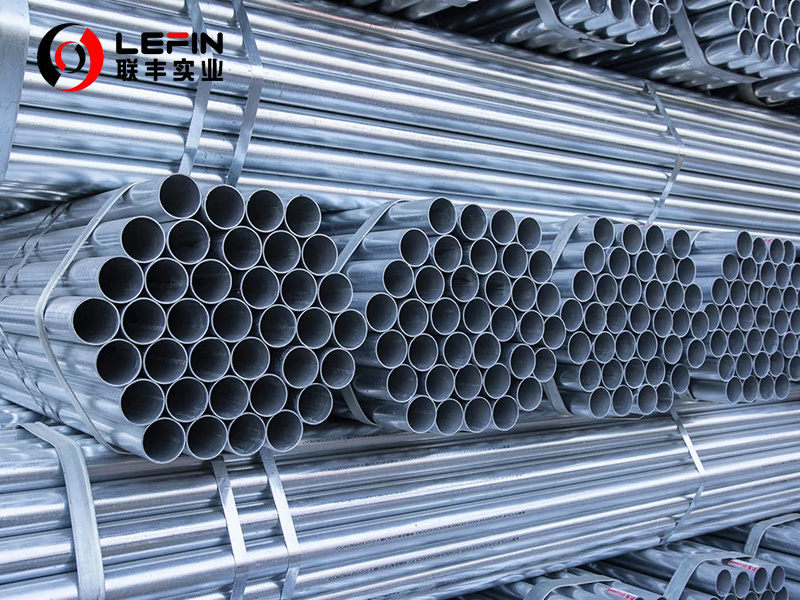





- Details
-
The following is a comprehensive introduction to EN 10255 galvanized steel pipe, covering key information such as its standard definition, material properties, application fields and market supply:
I. overview of the standard
EN 10255 is the technical standard for Non-alloy steel tubes in Europe, whose full name is "Non-alloy steel tubes suitable for welding and threading". This standard specifies the chemical composition, mechanical properties, dimensional tolerances and surface treatment requirements of steel pipes, with particular emphasis on its application to welding and threaded connection scenarios.
• Coverage range: Outer diameter 10.2mm to 165.1mm (corresponding to thread size 1/8" to 6"), divided into two series: Medium and Heavy, wall thickness range 0.8-10.0mm.• Galvanizing type: Through the hot-dip galvanizing (hot-Dipped Galvanized, HDG) process, a zinc layer (≥70 μm) is formed on the surface of the steel pipe, significantly enhancing its corrosion resistance.
II. Materials and performance characteristics
1. Chemical composition
• Main materials: Non-alloy steel (such as S195T, Q235B), with carbon (C) and manganese (Mn) as the main components, and the content of phosphorus (P) and sulfur (S) strictly controlled.- Typical component examples (S195T) : C≤0.20%, Mn≤1.40%, P≤0.035%, S≤0.030%.
2. Mechanical properties
Performance Index Requirement Values Yield strength ≥195 MPa Tensile strength 320-520 MPa The elongation (A5) ≥20% Density 7.75 g/cm³
3. Characteristics of galvanized coating
• Zinc coating weight: Typically ≥70 μm (approximately 500 g/m²), and for gas-specific pipes, it is even required to be ≥500 g/m² to enhance durability.• Anti-corrosion mechanism: The zinc coating protects the base steel pipe through the principle of sacrificial anode, extending its service life, especially suitable for damp or corrosive environments.

III. Dimensions and specifications
Parameter Range Outer diameter 1/2" - 12" (21.3-323.9 mm) The wall thickness 0.8-10.0 mm Length 1-12 m (customizable) The end treatment threads, grooves, flat mouths or protective covers IV. Manufacturing process and technical characteristics
1. Base tube production
The base tube is manufactured using high-frequency resistance welding (ERW) technology to ensure the uniformity of the weld seam.
2. Galvanizing process- Hot-dip galvanizing: Steel pipes are immersed in molten zinc (about 450°C) to form a metallurgical bonding layer.
- Post-treatment: It can be electrostatically sprayed with epoxy polyester paint (such as Jinzhou coated pipe) to form a dual protection of "zinc layer + coating", which has better anti-corrosion performance when used for gas pipelines.
3. Quality inspection
Including adhesion (GB/T 9286), impact resistance (≥70 kg·cm), hardness (≥2H) and acid resistance test.
V. application fields
• Fire protection system: Fire water supply network (working pressure ≤1.6 MPa), suitable for high-rise/underground buildings.
• Gas transmission: Urban gas pipeline networks (such as those of Hong Kong Gas and China National Petroleum Corporation), galvanized coating ≥ 500g /m².
• Building structure: Low-pressure fluid transportation, steel structure support, scaffolding system.
• General Engineering: HVAC systems, water conservancy projects and low-pressure pipeline networks.
VI. Quality certification and compliance with standards
CE certification: Complies with the EU Building Products Regulation (CPR, No 305/2011), and must pass tests such as sealing performance, durability, and dimensional tolerance.
International equivalent standard:
- ASTM A53/A500 (American Standard)
- BS 1387 (British Standard)
- JIS 3444 (Japanese Standard).

Summary
EN 10255 galvanized steel pipes have become the core materials for construction and fluid transportation systems due to their excellent weldability, thread compatibility and high anti-corrosion performance. Its standardized design (such as medium/heavy-duty classification) and dual protection process (galvanizing + coating) meet the demands of demanding scenarios like fire protection and gas. The global supply chain is mature, especially Chinese manufacturers, which have significant advantages in terms of cost performance and production capacity, making them suitable for bulk procurement in large-scale infrastructure projects.
EN 10255 GALVANIZED TUBE
Subcategory
Keyword
- Details
-
The following is a comprehensive introduction to EN 10255 galvanized steel pipe, covering key information such as its standard definition, material properties, application fields and market supply:
I. overview of the standard
EN 10255 is the technical standard for Non-alloy steel tubes in Europe, whose full name is "Non-alloy steel tubes suitable for welding and threading". This standard specifies the chemical composition, mechanical properties, dimensional tolerances and surface treatment requirements of steel pipes, with particular emphasis on its application to welding and threaded connection scenarios.
• Coverage range: Outer diameter 10.2mm to 165.1mm (corresponding to thread size 1/8" to 6"), divided into two series: Medium and Heavy, wall thickness range 0.8-10.0mm.• Galvanizing type: Through the hot-dip galvanizing (hot-Dipped Galvanized, HDG) process, a zinc layer (≥70 μm) is formed on the surface of the steel pipe, significantly enhancing its corrosion resistance.
II. Materials and performance characteristics
1. Chemical composition
• Main materials: Non-alloy steel (such as S195T, Q235B), with carbon (C) and manganese (Mn) as the main components, and the content of phosphorus (P) and sulfur (S) strictly controlled.- Typical component examples (S195T) : C≤0.20%, Mn≤1.40%, P≤0.035%, S≤0.030%.
2. Mechanical properties
Performance Index Requirement Values Yield strength ≥195 MPa Tensile strength 320-520 MPa The elongation (A5) ≥20% Density 7.75 g/cm³
3. Characteristics of galvanized coating
• Zinc coating weight: Typically ≥70 μm (approximately 500 g/m²), and for gas-specific pipes, it is even required to be ≥500 g/m² to enhance durability.• Anti-corrosion mechanism: The zinc coating protects the base steel pipe through the principle of sacrificial anode, extending its service life, especially suitable for damp or corrosive environments.

III. Dimensions and specifications
Parameter Range Outer diameter 1/2" - 12" (21.3-323.9 mm) The wall thickness 0.8-10.0 mm Length 1-12 m (customizable) The end treatment threads, grooves, flat mouths or protective covers IV. Manufacturing process and technical characteristics
1. Base tube production
The base tube is manufactured using high-frequency resistance welding (ERW) technology to ensure the uniformity of the weld seam.
2. Galvanizing process- Hot-dip galvanizing: Steel pipes are immersed in molten zinc (about 450°C) to form a metallurgical bonding layer.
- Post-treatment: It can be electrostatically sprayed with epoxy polyester paint (such as Jinzhou coated pipe) to form a dual protection of "zinc layer + coating", which has better anti-corrosion performance when used for gas pipelines.
3. Quality inspection
Including adhesion (GB/T 9286), impact resistance (≥70 kg·cm), hardness (≥2H) and acid resistance test.
V. application fields
• Fire protection system: Fire water supply network (working pressure ≤1.6 MPa), suitable for high-rise/underground buildings.
• Gas transmission: Urban gas pipeline networks (such as those of Hong Kong Gas and China National Petroleum Corporation), galvanized coating ≥ 500g /m².
• Building structure: Low-pressure fluid transportation, steel structure support, scaffolding system.
• General Engineering: HVAC systems, water conservancy projects and low-pressure pipeline networks.
VI. Quality certification and compliance with standards
CE certification: Complies with the EU Building Products Regulation (CPR, No 305/2011), and must pass tests such as sealing performance, durability, and dimensional tolerance.
International equivalent standard:
- ASTM A53/A500 (American Standard)
- BS 1387 (British Standard)
- JIS 3444 (Japanese Standard).

Summary
EN 10255 galvanized steel pipes have become the core materials for construction and fluid transportation systems due to their excellent weldability, thread compatibility and high anti-corrosion performance. Its standardized design (such as medium/heavy-duty classification) and dual protection process (galvanizing + coating) meet the demands of demanding scenarios like fire protection and gas. The global supply chain is mature, especially Chinese manufacturers, which have significant advantages in terms of cost performance and production capacity, making them suitable for bulk procurement in large-scale infrastructure projects.
Related products
Product Consulting

Address: Hengtai Road,Daqiuzhuang Town,Jinghai County,Tianjin,China
Mob: +8615122229899(whatspp)
Phone: +86 22 58171905
Fax: +86 22 58171902
E-mail:info@lefinsteel.com
Get company updates

Tianjin Lefin Industrial Co.,Ltd. All rights reserved City sub-station SEO www.300.cn

